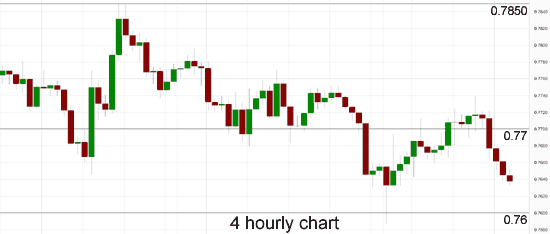AUD/USD – Thursday 2 July 2015
In the last few days the Australia dollar is starting to feel some selling pressure from the 0.77 level as its eyes remain firmly focused on the long term support level at 0.76. To close out last week the AUD/USD fell sharply lower below 0.77 however it found solid support from the long term support level at 0.76. This level has provided solid support throughout most of this year and has now been called upon again in the last week again. Throughout last week the AUD/USD eased lower and was enjoying support from the key 0.77 level before giving way. A couple of weeks ago it surged higher from below 0.77 up to a three week high, however it ran straight into resistance at the key 0.7850 level, which has performed this role several times this year. A couple of weeks ago it also spent most of its time trading quite steady around the 0.7750 level whilst receiving solid support from 0.77.
Over the last month the resistance level at 0.7850 has played a major role and continues to place selling pressure down on the AUD/USD. Throughout this same period it has been enjoying rock solid support from the long term support level at 0.76 which has allowed it to rebound strongly back up to above 0.78 on more than one occasion. Throughout the second half of May the Australian dollar fall sharply from a four month high above 0.8150 down to the key support level at 0.76. This level has been a significant level for a couple of months and has propped the Australian dollar up on multiple occasions. This recent price action has been a significant reversal as it wasn’t so long ago, the AUD/USD was in a solid medium term up trend having broken through the key 0.7850 level and achieved the four month high above 0.8150.
For most of this year the Australian dollar has traded within a wide trading range between the support at 0.76 and resistance around 0.7850. Earlier this year in February that range was tighter with the support level higher at 0.77. Throughout this period it experienced reasonable swings back and forth between the two key levels with very few excursions beyond the levels. The key level presently remains 0.76 and it will be interesting to see how well the support at this level can hold up and stop the strong down trend the AUD/USD has experienced over the last few weeks. The 4 hour chart below shows how steady the recent decline has been but equally how significant the 0.76 level in being able to temporarily halt the decline.
(Daily chart / 4 hourly chart below)
AUD/USD July 2 at 00:20 GMT 0.7641 H: 0.7641 L: 0.7633
AUD/USD Technical
| S3 | S2 | S1 | R1 | R2 | R3 |
| 0.7600 | — | — | 0.7850 | 0.8150 | — |
During the early hours of the Asian trading session on Thursday, the Australian dollar is easing back from the 0.77 level back towards the 0.76 after surging up to there in the last day or so. Current range: trading right below 0.7650.
Further levels in both directions:
• Below: 0.7600.
• Above: 0.7850 and 0.8150.
OANDA’s Open Position Ratios
(Shows the ratio of long vs. short positions held for AUD/USD among all OANDA clients. The left percentage (blue) shows long positions; the right percentage (orange) shows short positions.)
The long position ratio for AUD/USD has dropped back below 60% as the AUD/USD has eased back toward the 0.76 level. The trader sentiment is in favour of long positions.
Economic Releases
- 01:00 NZ ANZ Commodity Price (Jun)
- 01:30 AU Trade Balance (May)
- 08:30 UK CIPS / Markit Construction PMI (Jun)
- 09:00 EU PPI (May)
- 12:30 US Initial Claims (27/06/2015)
- 12:30 US Non-farm & Private Payrolls (Jun)
- 12:30 US Unemployment (Jun)
- 14:00 US Factory Orders (May)
- EU EU’s Juncker & Moscovici at EU Parliament in Brussels
* All release times are GMT
This article is for general information purposes only. It is not investment advice or a solution to buy or sell securities. Opinions are the authors; not necessarily that of OANDA Corporation or any of its affiliates, subsidiaries, officers or directors. Leveraged trading is high risk and not suitable for all. You could lose all of your deposited funds.



